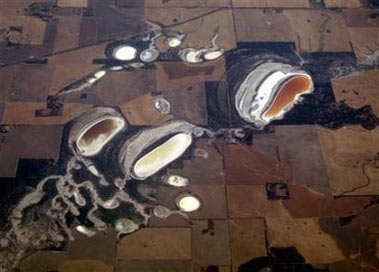I have been rather busy with the girls. Amber started the kindy start program at the local school on Tuesday. She had a great time and can't wait until next Tuesday when she can go again!
Next Tuesday is also her Birthday, she will be 5 years old.
Yesterday I did the usual driving backwards and forwards, Mum's taxi routine with Amber at preschool and Jade at school. And today I have to take Amber to a friends Birthday party. I will probably do some shopping while Amber is at the party.
There has been alot of talk about food prices increasing in NSW beacause of the drought. I can't believe how expensive fruit and vegetables are already without them going up even more - inparticular, Bananas $12 a kilo and Grapes $17 a kilo. So, speaking of the drought, I thought I would post some photos of how rural Australia is suffering.

Above: Cattle scrounge for fodder on a drought stricken property near Toowoomba. Australia's worst drought in living memory is threatening the booming economy of the driest continent on earth, driving global warming and nuclear power to the forefront of political debate.

Above: Salt-infested dams can be seen in the drought-effected farming areas on the outskirts of the Western Australian capital city of Perth. Australia is already feeling the brunt of climate change with a five year drought devastating rural life and eating into economic growth, severe early season wildfires and record unseasonable temperatures.

Above: A farmer feeds his cattle on his property near the New South Wales town of Gunnedah, located 370 miles northwest of Sydney.
One Australian farmer commits suicide every four days, defeated by the country's worst drought in 100 years which has left them with dust-bowl paddocks and a mountain of debt, says a national mental health body.

Above: The Pejar Dam, in the heart of sheep grazing country and a water supply for the city of Goulburn, about 150 km (93 miles) southwest of Sydney, is seen almost empty.

Above: Sheep scratch for feed on a drought-affected farm near Cowra, about 260 kilometres (162 miles) west of Sydney.

Above: Grazing cattle raise a cloud of dust as they scratch for food on a drought-affected farm near Goulburn, about 170 km (105 miles) southwest of Sydney.
This drough is turning much of Australia's farmland to dust and is pushing the once-top grains exporting nation closer to importing wheat for only the second time in its history.
Picture was taken through a car window during a dust storm.

Above: Sheep stir up dust as they move across the dried-up water basin known as Lake George, located 20 kilometres (8 miles) north-east of Canberra November 10, 2006.
Living in the world's driest inhabited continent, Australians are used to wild schemes promising deliverance from drought and precious water. But with Government officials saying last week that the drought gripping Australia could be the worst in 1000 years, emergency plans are being drawn up to secure long-term water supplies to towns and cities.
Previously it was thought that the drought effecting more than half the country's farmlands was the worst in just 100 years, and with rivers disappearing and a searing spring, desperate farmers are being asked to pack up and open a 'new agricultural frontier' in the tropical north.
Influential lawmakers want farmers to abandon marginal irrigation lands such as the Murray-Darling river basin, which sprawls across three eastern states and covers an area the size of France and Spain combined.

Above: Drought ravaged Gayngaru wetlands of Arnhem Land in the Northern Territory.
Australia's worst drought in recorded history will cut its wheat crop to its lowest level in 12 years and cut economic growth by around 0.7 percent.

Above: The knarled remains of a mangrove lies testament to the devastating effects of salination in the drought ravaged Northern Territory.

Above: Graphic on rainfall in Australia.
Australia, already the world's driest inhabited continent, is in the grip of its worst drought in 1,000 years, a leading expert told the country's political leaders at a crisis summit.
Above: A Sydney Catchment Authority employee stands on a sandbank at Warragamba Dam showing the water level in the lake west of Sydney, at 16 meters (52 feet) below where it should be.
Sydney's largest reservoir that provides water to Australia's largest city of 4 million residents, officially slipped below 40 per cent Thursday, Nov 2, 2006 as the effects of Australia's drought continue to diminish major cities water supplies.

Above: A sign shows the level of full capacity for Sydney's Warragamba Dam.

Above: A New South Wales fireman.
Firefighters in Australia's most populous state are bracing for more trouble as temperatures soar to near record highs, scorching the drought-ridden region further.
Technorati Tags -
Australia ~ Australian Drought ~ New South Wales ~ New South Wales Drought ~ Rural New South Wales ~ Rain ~ Sheep ~ Cattle ~ Bushfire ~ Life ~ Photos ~ Weblog ~ Blog
.... Just another day ....


No comments:
Post a Comment